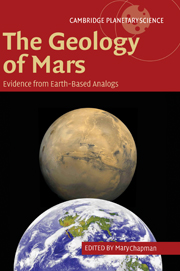Book contents
- Frontmatter
- Contents
- Preface: the rationale for planetary analog studies
- List of contributors
- 1 The geology of Mars: new insights and outstanding questions
- 2 Impact structures on Earth and Mars
- 3 Terrestrial analogs to the calderas of the Tharsis volcanoes on Mars
- 4 Volcanic features of New Mexico analogous to volcanic features on Mars
- 5 Comparison of flood lavas on Earth and Mars
- 6 Rootless volcanic cones in Iceland and on Mars
- 7 Mars interior layered deposits and terrestrial sub-ice volcanoes compared: observations and interpretations of similar geomorphic characteristics
- 8 Lava—sediment interactions on Mars: evidence and consequences
- 9 Eolian dunes and deposits in the western United States as analogs to wind-related features on Mars
- 10 Debris flows in Greenland and on Mars
- 11 Siberian rivers and Martian outflow channels: an analogy
- 12 Formation of valleys and cataclysmic flood channels on Earth and Mars
- 13 Playa environments on Earth: possible analogs for Mars
- 14 Signatures of habitats and life in Earth's high-altitude lakes: clues to Noachian aqueous environments on Mars
- 15 The Canyonlands model for planetary grabens: revised physical basis and implications
- 16 Geochemical analogs and Martian meteorites
- 17 Integrated analog mission design for planetary exploration with humans and robots
- Index
- Plate section
- References
2 - Impact structures on Earth and Mars
Published online by Cambridge University Press: 18 September 2009
- Frontmatter
- Contents
- Preface: the rationale for planetary analog studies
- List of contributors
- 1 The geology of Mars: new insights and outstanding questions
- 2 Impact structures on Earth and Mars
- 3 Terrestrial analogs to the calderas of the Tharsis volcanoes on Mars
- 4 Volcanic features of New Mexico analogous to volcanic features on Mars
- 5 Comparison of flood lavas on Earth and Mars
- 6 Rootless volcanic cones in Iceland and on Mars
- 7 Mars interior layered deposits and terrestrial sub-ice volcanoes compared: observations and interpretations of similar geomorphic characteristics
- 8 Lava—sediment interactions on Mars: evidence and consequences
- 9 Eolian dunes and deposits in the western United States as analogs to wind-related features on Mars
- 10 Debris flows in Greenland and on Mars
- 11 Siberian rivers and Martian outflow channels: an analogy
- 12 Formation of valleys and cataclysmic flood channels on Earth and Mars
- 13 Playa environments on Earth: possible analogs for Mars
- 14 Signatures of habitats and life in Earth's high-altitude lakes: clues to Noachian aqueous environments on Mars
- 15 The Canyonlands model for planetary grabens: revised physical basis and implications
- 16 Geochemical analogs and Martian meteorites
- 17 Integrated analog mission design for planetary exploration with humans and robots
- Index
- Plate section
- References
Summary
Introduction
Every solid-surfaced body in the Solar System except Io shows evidence of the impact cratering process, and Comet Shoemaker-Levy 9 showed that impacts can even temporarily leave their mark on gas planets. Earth's active geologic environment has erased much of its cratering record, particularly from the early episode of high impact rates known as the late heavy bombardment period (>3.8 Gyr ago). In comparison, ∼60% of the Martian surface preserves the late heavy bombardment record. Mars retains the most complete record of impact cratering in the entire Solar System (Barlow, 1988) and these craters display a range of morphologic features seldom seen on other solid-surface bodies. Comparison of terrestrial and Martian craters provides a more thorough understanding of impact structures: Mars preserves the pristine morphologic features which erosion has largely destroyed for terrestrial craters, but terrestrial studies allow us to understand subsurface structures and materials resulting from impact for which we currently have no information on Mars. Presence of an atmosphere and subsurface volatiles suggests that crater formation may be more similar on these two bodies than between Earth and Moon.
Understanding how impact craters form results from laboratory experiments, computer simulations, nuclear and chemical explosions, and terrestrial crater studies. Laboratory experiments were instrumental in realizing that high-velocity impacts create approximately circular craters except at low impact angles (Gault and Wedekind, 1979). Nuclear and large chemical explosions provided the first opportunity to study the physics of crater formation (Oberbeck, 1977).
- Type
- Chapter
- Information
- The Geology of MarsEvidence from Earth-Based Analogs, pp. 47 - 70Publisher: Cambridge University PressPrint publication year: 2007
References
- 2
- Cited by

